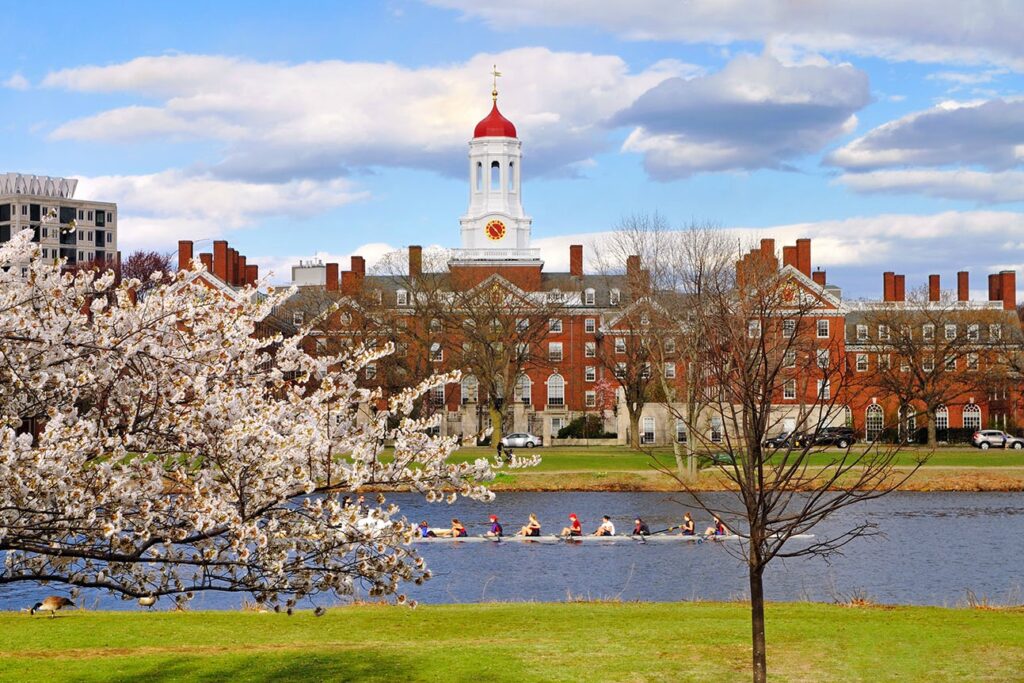Introduction
When it comes to top universities in the USA, two names dominate almost every list — Harvard University and Stanford University.
Both are world-renowned for their academic excellence, research output, and global alumni network, but each has a unique culture, location, and academic focus.
Whether you are a high school graduate planning for undergraduate studies or a professional considering graduate school, the debate of Harvard vs Stanford is worth exploring.
This detailed guide compares Harvard and Stanford on rankings, acceptance rates, tuition fees, academic programs, career opportunities, and student experience — so you can make an informed decision.
Quick Overview
| Feature | Harvard University | Stanford University |
|---|---|---|
| Founded | 1636 (Oldest Ivy League University) | 1885 (Leading West Coast University) |
| Location | Cambridge, Massachusetts (East Coast) | Stanford, California (West Coast) |
| Global Rank (2025) | #3 (QS World University Rankings 2025) | #5 (QS World University Rankings 2025) |
| Student Population | ~25,000 | ~17,000 |
| Acceptance Rate | ~3.4% (Highly Competitive) | ~3.7% (Highly Competitive) |
| Tuition Fees | ~$57,000 per year | ~$56,000 per year |
| Strengths | Law, Business, Medicine, Humanities | Engineering, Technology, Innovation |
Academic Excellence
Harvard University
Harvard is globally known for its Ivy League prestige and strong programs in:
- Law (Harvard Law School)
- Business (Harvard Business School)
- Medicine (Harvard Medical School)
- Political Science, Economics, and Public Policy
It emphasizes research, critical thinking, and leadership development, producing some of the world’s most influential leaders, presidents, and Nobel Prize winners.
Stanford University
Stanford, located in the heart of Silicon Valley, is synonymous with innovation and entrepreneurship. It excels in:
- Engineering and Computer Science
- Business (Stanford GSB)
- Artificial Intelligence and Data Science
- Environmental Sciences and Design
Stanford’s strong industry connections make it a launchpad for tech entrepreneurs and startup founders.
Location and Campus Life
Harvard’s Campus Life
Harvard is based in Cambridge, Massachusetts, a historic college town with a strong East Coast academic vibe.
- Traditional campus architecture
- Close to Boston (city life + networking opportunities)
- Strong emphasis on student societies, debate clubs, and research
Stanford’s Campus Life
Stanford’s 8,000+ acre campus is one of the largest in the world.
- Located near Silicon Valley — ideal for tech networking
- Mild California weather year-round
- Modern, innovation-driven campus culture
Acceptance Rate and Competitiveness
Both Harvard and Stanford are extremely selective.
| Metric | Harvard | Stanford |
|---|---|---|
| Acceptance Rate | ~3.4% | ~3.7% |
| SAT/ACT Range | 1500–1580 SAT / 34–36 ACT | 1480–1570 SAT / 33–35 ACT |
| International Student Percentage | ~13% | ~11% |
To get accepted into either, students need:
- Top academic scores
- Strong extracurriculars
- Leadership experience
- Excellent essays and recommendation letters
Tuition Fees and Financial Aid
Harvard
- Tuition: ~$57,000 per year
- Total Cost (with housing & meals): ~$80,000 per year
- Financial Aid: Need-blind for international students, generous scholarships available
Stanford
- Tuition: ~$56,000 per year
- Total Cost (with housing & meals): ~$78,000 per year
- Financial Aid: Need-based aid, work-study programs available
Both universities have strong endowments and offer financial aid packages to make education accessible.
Career Opportunities
Harvard Graduates
- High demand in consulting, law, finance, medicine, and public policy
- Access to an elite alumni network including CEOs, presidents, and Nobel laureates
- Average salary for Harvard graduates: ~$95,000/year (depending on field)
Stanford Graduates
- Preferred by tech companies, startups, and venture capital firms
- Students often start companies while studying (Google, Yahoo, Instagram founders are Stanford alumni)
- Average salary for Stanford graduates: ~$100,000/year (higher for tech roles)
Pros and Cons
✅ Harvard Advantages
- Oldest Ivy League reputation
- Strong humanities, law, and medicine programs
- Generous need-blind financial aid
- Historic East Coast networking
❌ Harvard Disadvantages
- Competitive and traditional environment
- Weather can be cold (Boston winters)
✅ Stanford Advantages
- Location near Silicon Valley (startup hub)
- Strong engineering, tech, and business programs
- Modern, collaborative culture
- Sunny California weather
❌ Stanford Disadvantages
- Slightly less traditional prestige compared to Ivy League
- Cost of living in California is very high
Which One Should You Choose?
- Choose Harvard University if you:
- Prefer traditional Ivy League prestige
- Are interested in law, medicine, political science, humanities
- Want an East Coast academic and cultural experience
- Choose Stanford University if you:
- Want to study engineering, computer science, AI, or entrepreneurship
- Prefer a modern, innovation-driven campus
- Dream of working in tech or starting your own company
FAQs
Q1: Which is harder to get into, Harvard or Stanford?
Both are extremely competitive, but Stanford has a slightly lower acceptance rate in some years.
Q2: Which university is better for technology?
Stanford is generally considered the best for technology, AI, and entrepreneurship because of its Silicon Valley location.
Q3: Which has better financial aid?
Harvard is known for its need-blind admissions and extremely generous financial aid packages.
Q4: Can international students apply to both?
Yes! Both welcome international students and provide scholarships and need-based aid.
Conclusion
The Harvard vs Stanford debate comes down to personal preference, career goals, and location choice.
- Harvard offers Ivy League tradition, academic prestige, and strong humanities, law, and medicine programs.
- Stanford offers innovation, entrepreneurship, and tech-driven opportunities with a modern learning environment.
Both universities will open global doors for your future. Choose the one that aligns with your passion, field of study, and dream career path.




